Table of Contents
- Newsjacking earns high-authority links fast by injecting timely, expert commentary into trending news stories.
- Three proven tactics: insert expert quotes, pitch new content tied to breaking news, or leverage relevant existing assets.
- Speed and relevance are critical—missing the news cycle window or lacking topic authority can tank campaigns.
- Set up daily news monitoring and pre-drafted quotes to react quickly to planned or breaking events.
- BuzzStream streamlines the process, from building media lists to sending personalized pitches.
Want to leverage hot trends and breaking news to get high-authority links from top publications?
Let me introduce you to newsjacking.
It’s a tactic that can be used by virtually any company, brand, agency, or in-house team. You can get quick links and leverage trending topics to generate massive coverage.
But, of course, the details matter. Fortunately for you, we’ve got the inside scoop from some of the top teams leveraging this powerful tactic, and we will share the secret sauce.
Here is how to use newsjacking in your digital PR strategy to win big.
What Exactly is Newsjacking?
Newsjacking is leveraging trending or breaking news to spotlight your brand and earn top-tier news coverage and links.
For those who want a deeper dive into history, the term “newsjacking” officially comes from author David Meerman Scott, who coined the phrase in his excellent book (Newsjacking).
He says, “It is about taking advantage of opportunities that pop up for a fleeting moment, then disappear. In that instant, if you are clever enough to add a new dimension to the story in real-time, the news media will write about you.”
So, put another way, newsjacking is about reacting to a trend and capitalizing on it.
Now, let’s look at how teams actually put this strategy into practice.
Main Newsjacking Tactics
We’ve spoken with dozens of top-performing digital PR teams that have successfully leveraged newsjacking for over a decade.
Based on those conversations, they regularly use three primary tactics.
Below, I’ll give an overview of each, and then later in the post, I’ll walk you through building your own process.
1. Insert Expert Commentary
Expert commentary is the most commonly used newsjacking tactic.
Digital PRs do this by contacting journalists and providing critical statistics or insight that gives value to breaking or trending stories.
For example, when superstar celeb Ariana Grande got engaged, Denis Stepansky, from luxury jewelry retailer ItsHot, reached out to Entertainment Tonight with this quote estimating the cost of her ring:

In this case, the brand added something new to a current, breaking story, making it invaluable for a journalist.
2. Create New Content That Adds to Breaking News
You can create new web or social content, such as images, videos, or text, to insert your brand in a trending news topic.
The most obvious example of social content is the Oreo Tweet during the Superbowl blackout.
When the lights went out, they were among the first to post about it, connecting their brand to the event. This approach is challenging because social content has a shorter shelf life and is also less likely to drive traffic or links to your website.
However, some digital PRs create new content on their site or blog and pitch it to journalists to jack a news story.
Creating new content is difficult for breaking news because it requires creating and publishing brand-new content.
But, if you know an event is coming, you can prepare beforehand.
For example, when the Affordable Connectivity Program announced it was ending in May 2024, Sage Singleton of Clearlink prepared to newsjack the ending date for their client Whistleout.com, a mobile and internet plans comparison site.
Sage and the team rushed to create a full report outlining who would be impacted and where they could get replacement coverage.

Then, when the day finally came, they pitched their study to journalists.
3. Use Existing Content to Pitch Yourself as an Expert or Resource
Some sites have existing content that adds to a breaking story, and PRs will pitch that to journalists.
For example, Will Hobson, VP of PR at digital PR agency Rise at Seven, told me how they leveraged Lyst’s sales data to show a spike in sales for the white slip-on shoes shown in Squid Game when the show was trending.
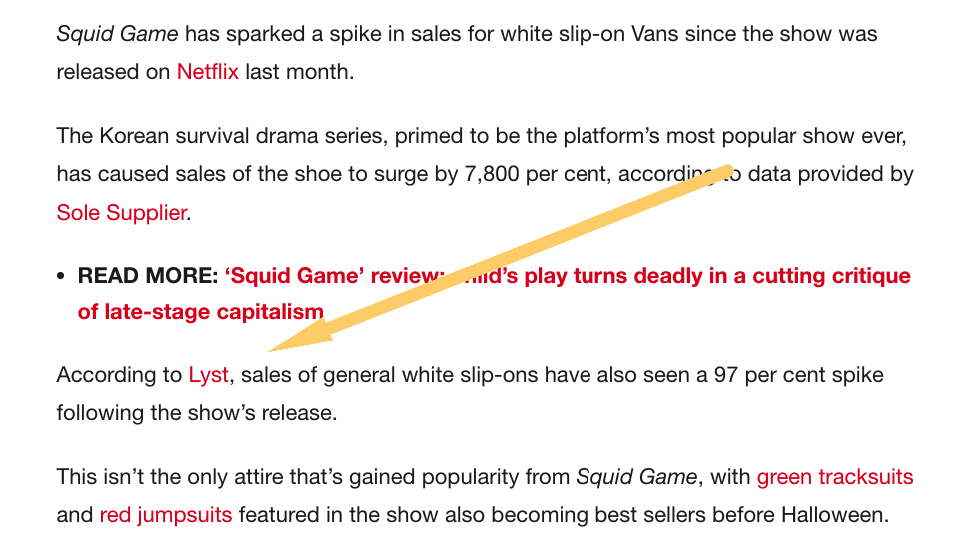
This approach allows you to pick up links to existing content, though it can fail if it is too outdated.
Now that we know the tactics let’s learn how to build your newsjacking process.
How to Build Your Own Newsjacking Process
I’ve found that the newsjacking process always feels more daunting than it is. The most difficult part for people is finding the right news to leverage and connecting the dots to your brand.
So, here’s a step-by-step process for working newsjacking into your digital PR process, which you can use in-house or at an agency.
1. Create a News Review Process
This first step is sort of a pre-step to the following steps. I recommend creating a weekly news review where you monitor and discuss actions to take on any trends relevant to your brand or client.
A review process might look something like this:
- You (and your team) devote 15-30 minutes each morning to reading the top news.
- Set up a Slack channel or chat to share breaking or relevant news that you could leverage for immediate coverage.
- You (and your team) then meet (at least weekly) to share headlines of major relevant news stories and discuss how/if your brand can news jack.
In the next step, I’ll explain how and where to find relevant news. But for now, I want to highlight the process.
Our team at BuzzStream has a fairly straightforward news review process.
I read several SEO and PR-related newsletters, check Reddit, X, and LinkedIn, and note significant trends every morning.
Then, I will share this significant news in our weekly all-hands meetings.
Our team also has an active Slack channel where we share any relevant news that might be worth trying to newsjack in one way or another.
It can be as simple as this note from Kristen:

This prompted us to investigate the breaking news about Google changing its email requirements.
We leveraged this into this highly successful post for us about Google and Yahoo’s Email Requirements for 2024:
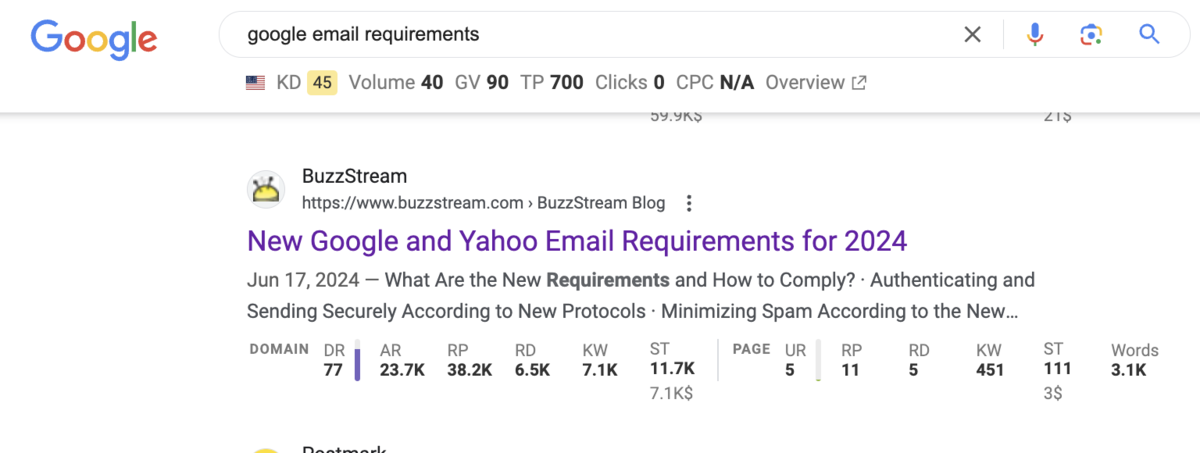
But let’s not get too far ahead of ourselves. First, we need to find the relevant news sources.
2. Find and Monitor Relevant Breaking News and Trends
The next step is gathering your news sources, including alerts, newsfeeds, newsletters, and hashtags.
There are plenty of places to collect and monitor breaking news and trends.
- Look at Google Trends daily
- Look at trending hashtags on X
- Read the news (both general and industry-specific)
- Subscribe to industry newsletters
- Set up Google Alerts or Talkwalker alerts
- Ask ChatGPT what is trending in your industry
Finding the news outlets can sometimes be challenging, but a simple Google search can help you find your industry’s most relevant news sources.
For instance, if I’m working in construction, I can type “construction news” and find plenty of outlets.
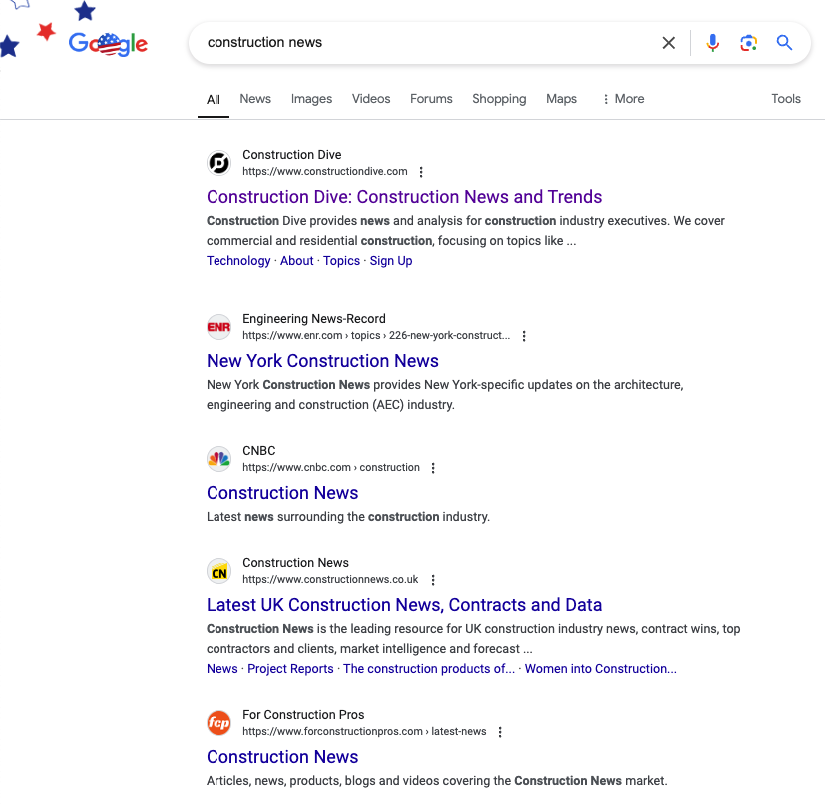
I can do the same for “construction newsletters.”
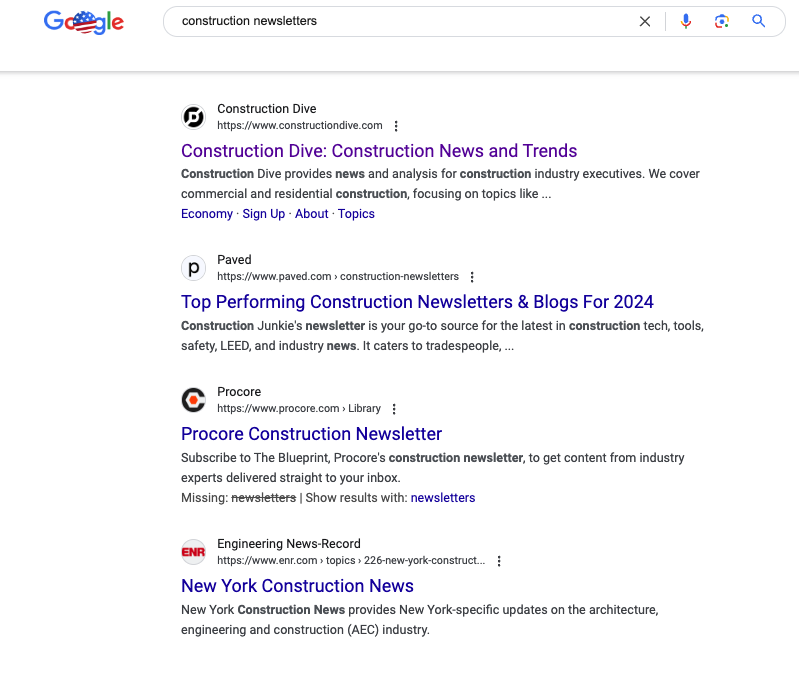
For a more detailed look at one of the workflows, let’s walk through how you can use Google Trends to find relevant trends for newsjacking.
Using Google Trends to Find Relevant Trends for Newsjacking
Head to the platform and click the “Trending now” tab.
As I write this, you can see several new trends in the US within the past 24 hours.
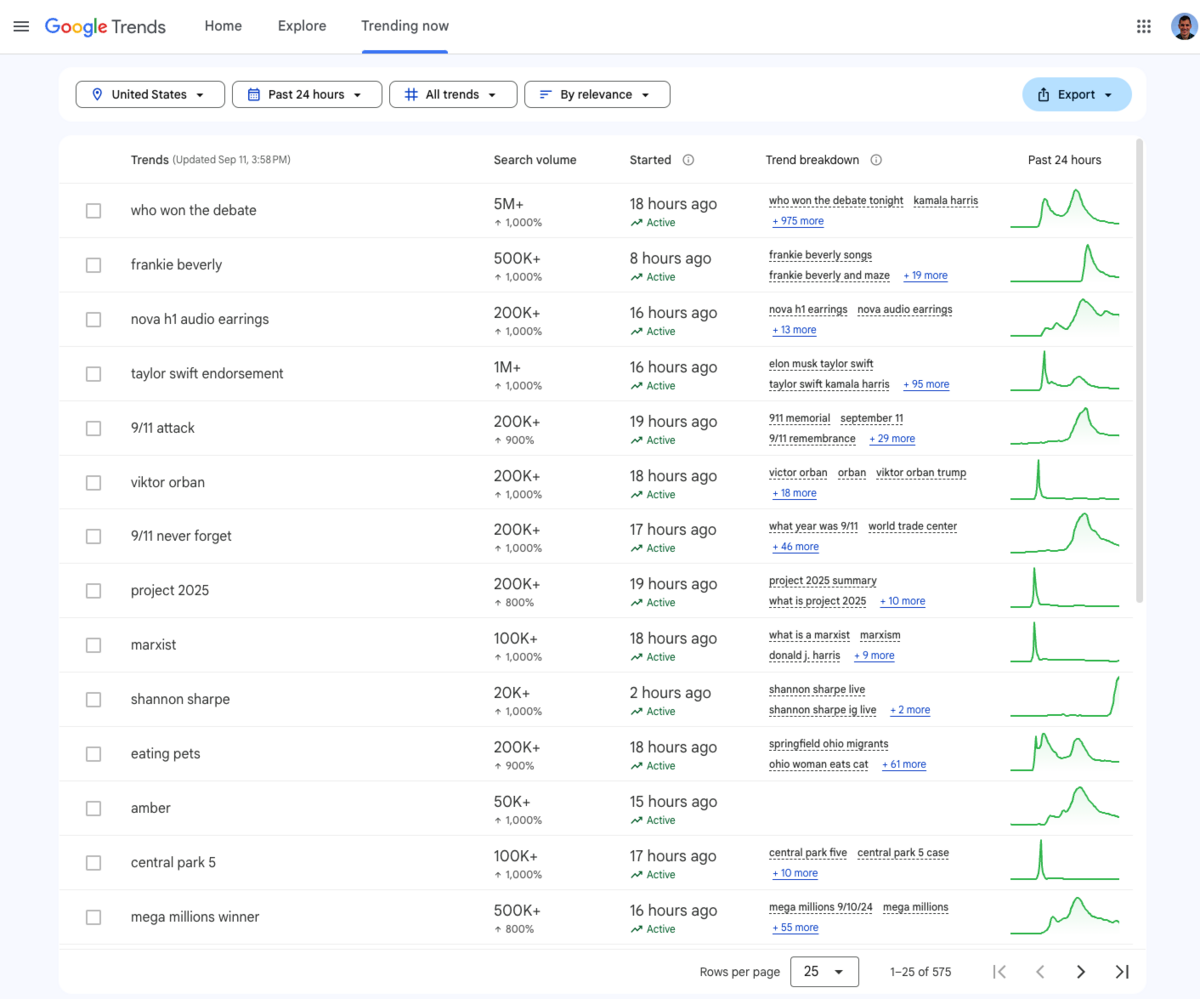
Let’s pretend that we are a personal finance brand.
Ignoring the presidential debate topics, I saw ” Mega Millions Winner,” which piqued my interest as a personal finance brand because it concerns money.
If I click on it, Trends shows more details, including a zoomed-in version of the trend line and links to the news articles people have already written about it.
Now that I’ve identified a relevant trend or news item, the next step is to figure out how to connect it to our brand or website for newsjacking.
3. Connect News To Your Site or Service for Newsjacking
Once you have relevant news, the key to newsjacking is to add value to a story with your expertise.
First, read through the current coverage.
Then, to figure out how and if your site can add value, here are some questions to ask:
- Who is this news impacting? How do they relate to my brand?
- What data is missing from the current coverage? What could I add?
- Are there any misconceptions or gaps in the story?
- What problems arise from the story that no one is talking about?
- What unique insights or predictions can I offer?
- How could this development impact the future of my industry?
- What are the potential benefits or opportunities I can highlight from this story?
For instance, with the Mega Millions story, $800 million is a lot of money. When you look through the coverage, it’s all about the money.
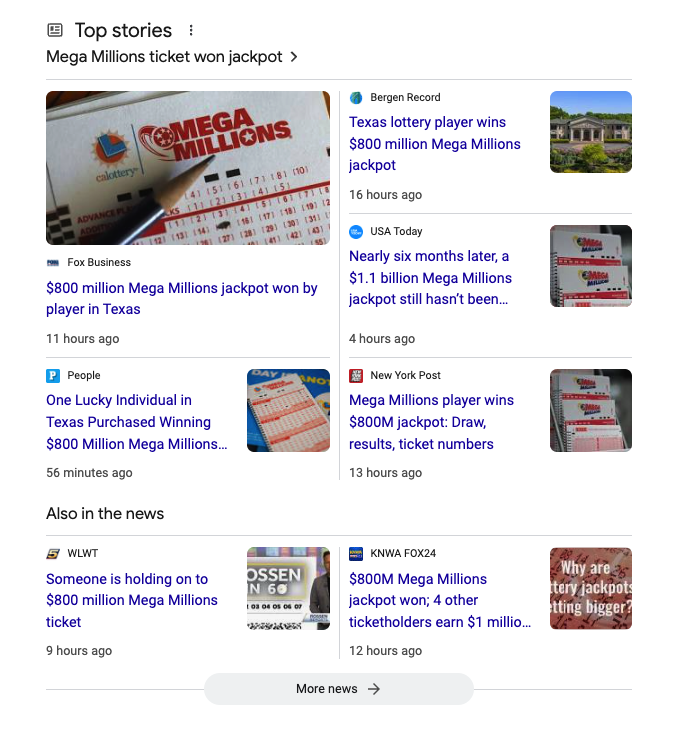
But no one is talking about what to do after you win money like that or the tax implications of making $800 million at once.
Those are angles I could take with our personal finance brand. Maybe we have an existing guide about managing large sums of money, like Ellevest writes about there.
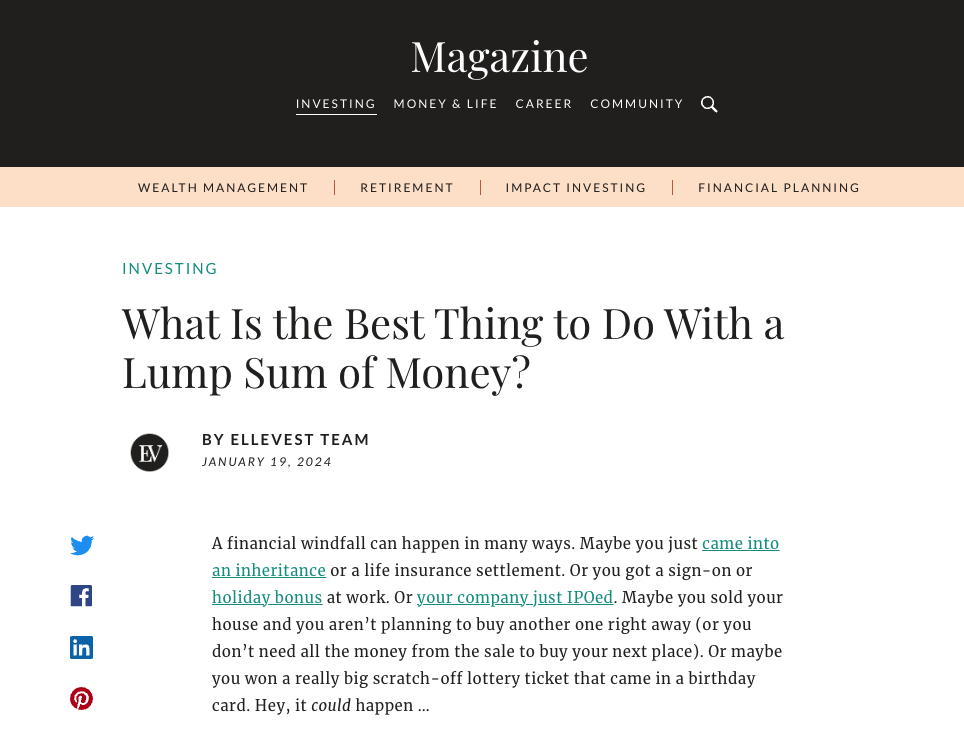
Or maybe we could tap our CEO or financial advisor to provide some quotes about it because it is definitely something that gets covered in the news, as we’ve seen before on sites like CNBC around major drawings:
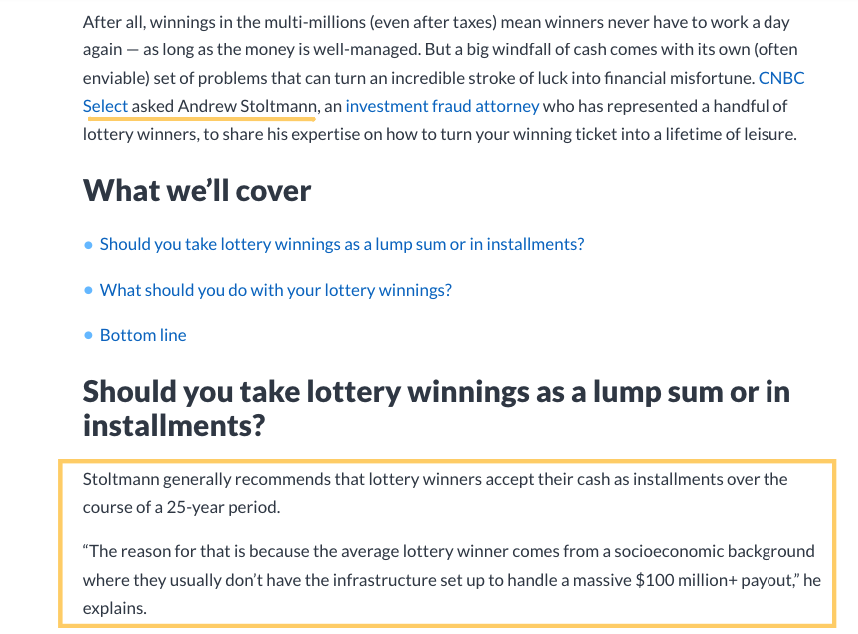
These are new data or quotes that a journalist doesn’t have and add much value to a story.
Once you have your topic, it’s time to target the journalists.
4. Build Your Media List
We’ve got excellent guides on how to find journalists and how to build a media list (for free), but in short, the most straightforward way to newsjack is to find journalists who are currently talking about the topic.
You can do this with a simple Google News search.
So, if I were newsjacking the Mega Millions winner, a Google search would find me sites that cover the news.

Then, by clicking each article, I can determine if the journalist is the right fit.
For example, the first on the list is a Cleveland.com article by Cliff Pinkard.

Given that Cliff already wrote about the lottery winner, there’s a high likelihood that Cliff is relevant for a pitch.
But, I always like to click in to review a journalist’s latest articles.
It looks like Cliff has written about the Powerball, so I feel great about pitching Cliff.
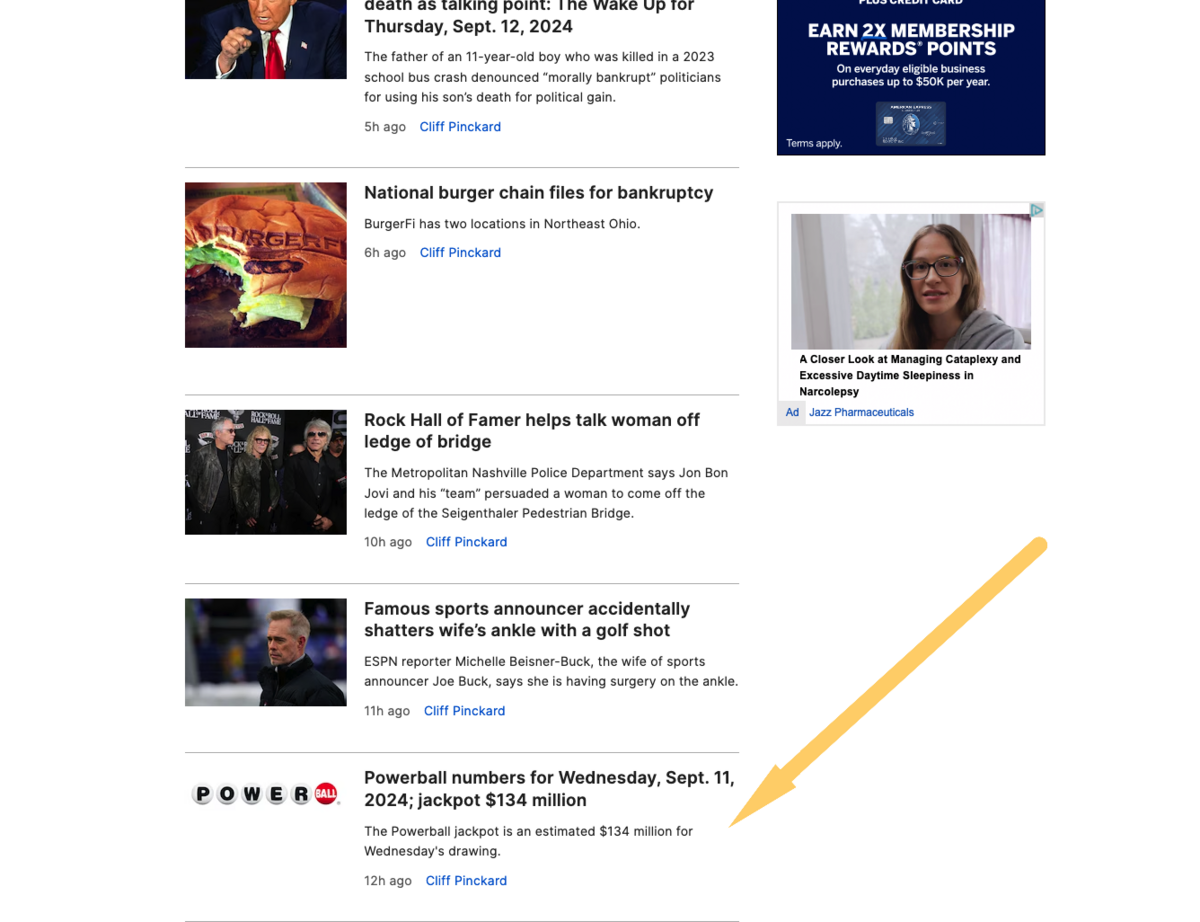
I’ll show you how to craft your pitch in the next section, but before we do, I want to discuss pre-building media lists.
Building Media Lists Ahead of Time
Some agencies build media lists even before you have a news story.
For instance, Sage Singleton from Clearlink told us she creates specific lists of journalists for different industries.
This way, she can use these lists to newsjack the second a relevant story breaks.
Here’s what that looks like in BuzzStream:

The process is exactly the same as the one I outlined above, but instead of focusing on a current event, you can focus on similar previous events.
For example, if I wanted to prepare a media list for a future Mega Millions drawing, I could do a Google search for Mega Millions but set my date range to six months to see journalists writing about prior winners or drawings.
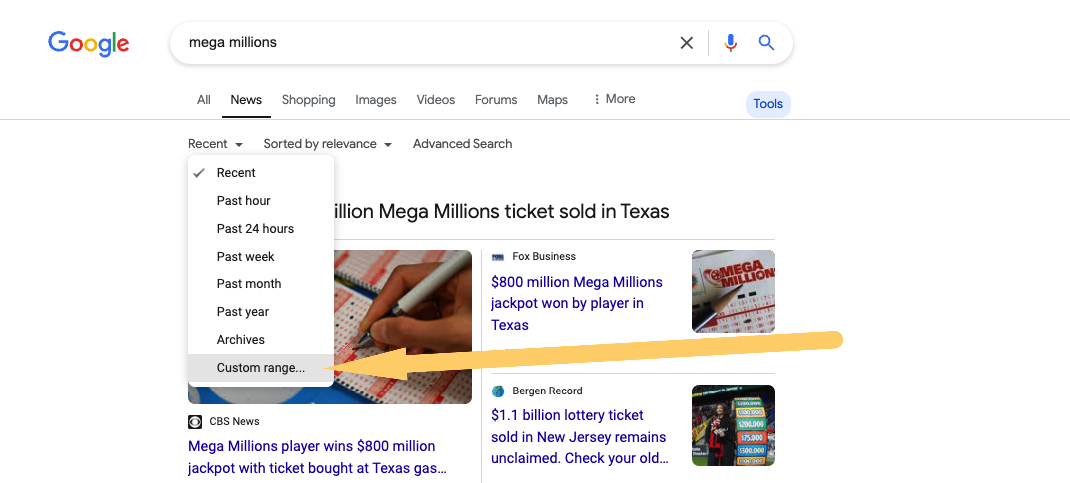
Now I can start building a list of journalists who have covered this topic in the past.
With that out of the way, let’s talk about pitch emails.
5. Pitching For Newsjacking
A newsjacking pitch is not much different from any other media pitch.
Most pitches look something like this:
- Current event recap
- Context from your brand
- Export quote
- Offer interview or more
If we were pitching a quote to a journalist about interest rates dropping and how it impacts millennials’ investments, we might say something like this:
As interest rates drop today, many millennials wonder how it will affect their financial decisions, from mortgages to savings accounts.
At FinanceSmarts, an investment app for millennials, we are committed to breaking down complex financial changes and offering clear, actionable advice for millennials.
Here’s a quote from our financial expert, John Smith, on what consumers should know:
“For millennial investors, a drop in interest rates might initially seem like a win, especially regarding borrowing and refinancing options. However, it also presents a challenge in terms of lower returns on savings accounts and bonds, which are typically safer investment options.
We encourage millennials to explore more growth-focused investments like stocks or ETFs while monitoring their risk tolerance.
Diversifying portfolios and seeking opportunities in emerging markets or sustainable investments could be vital to navigating this low-rate environment.”
If you’re covering this story, we’d love to contribute with further insights or data on how this rate shift may affect [your target audience].
Let me know if you’re interested in discussing this further!
If you are pitching existing, new, or social content, you’ll also include a link and any assets.
Read more about how to pitch journalists.
Newsjacking with BuzzStream
The newsjacking process with BuzzStream is simple.
Let’s pretend we are doing a newsjacking post about Linkin Park’s new singer, Emily Armstrong, who is trending in the US today.
Linkin Park is about to embark on a new tour, and Armstrong is replacing Chester Bennington, who died over six years ago.
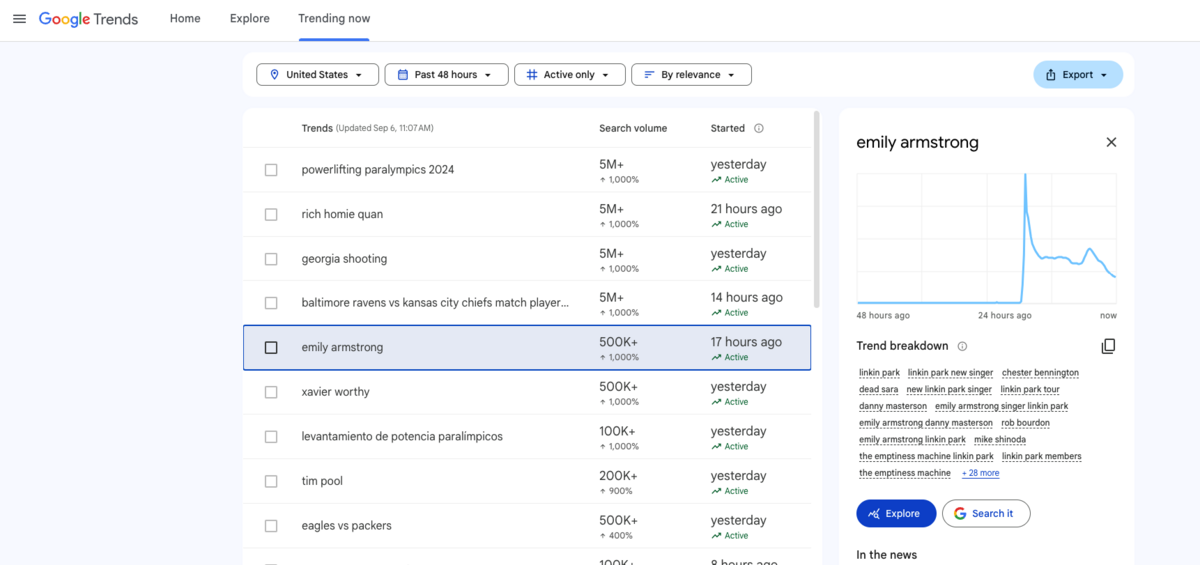
In our example, pretend we’ve done a data study around how bands perform after a replacement singer joins.
Research Journalists for a Media List
To build a newsjacking outreach list in BuzzStream, start and name a new project.

Then, to build my media list, I’ll go to “Research Lists” and click Create a Research List.
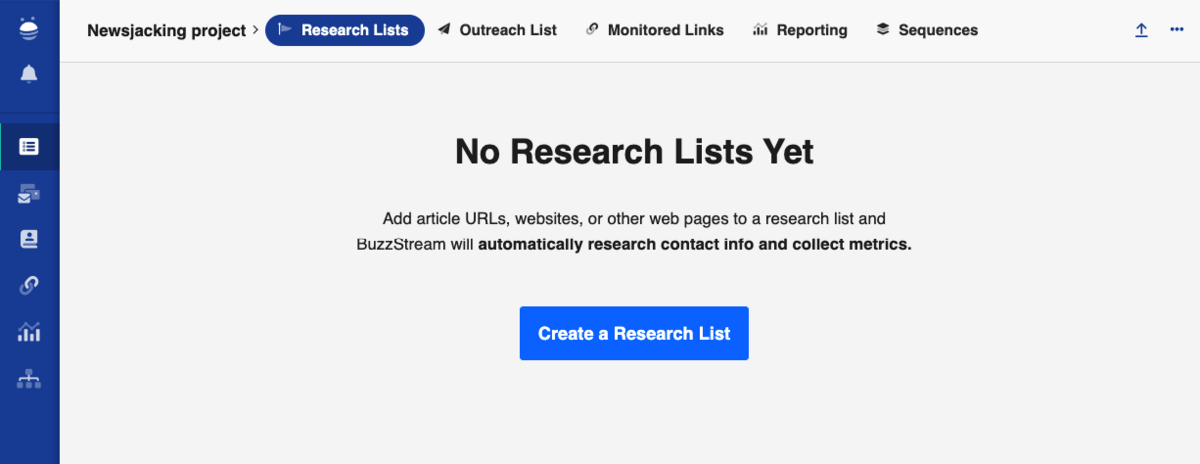
Now, I’ll build my list based on a Google News search for “Emily Armstrong.” I’ll click Search News.
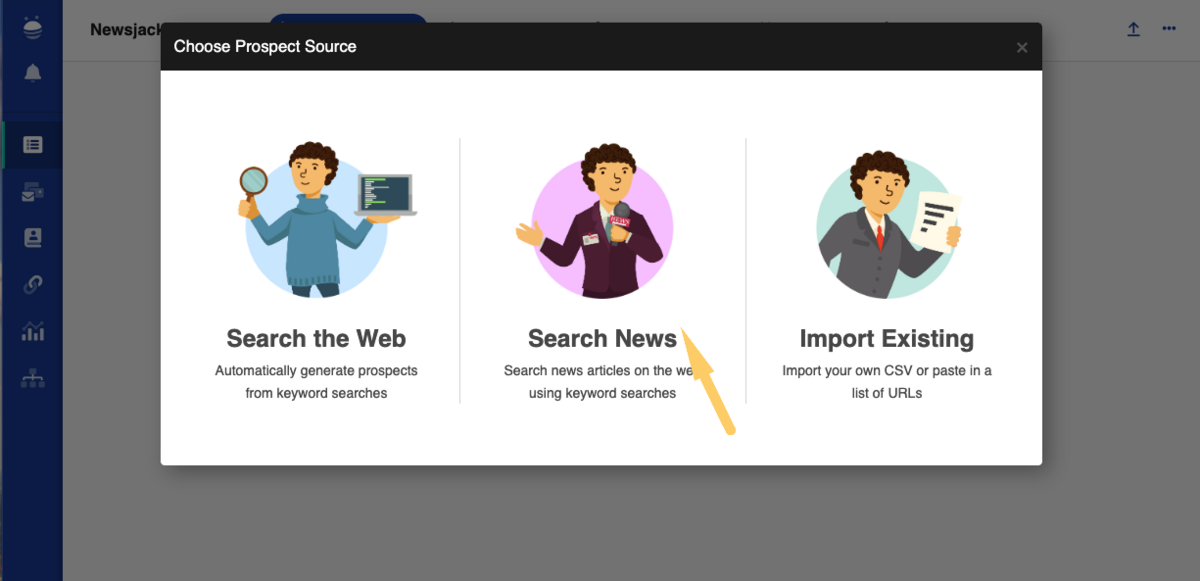
Then, I’ll use the search terms, Emily Armstrong and Linkin Park.
Importantly, I’ll set the date and timeframe for the past week.
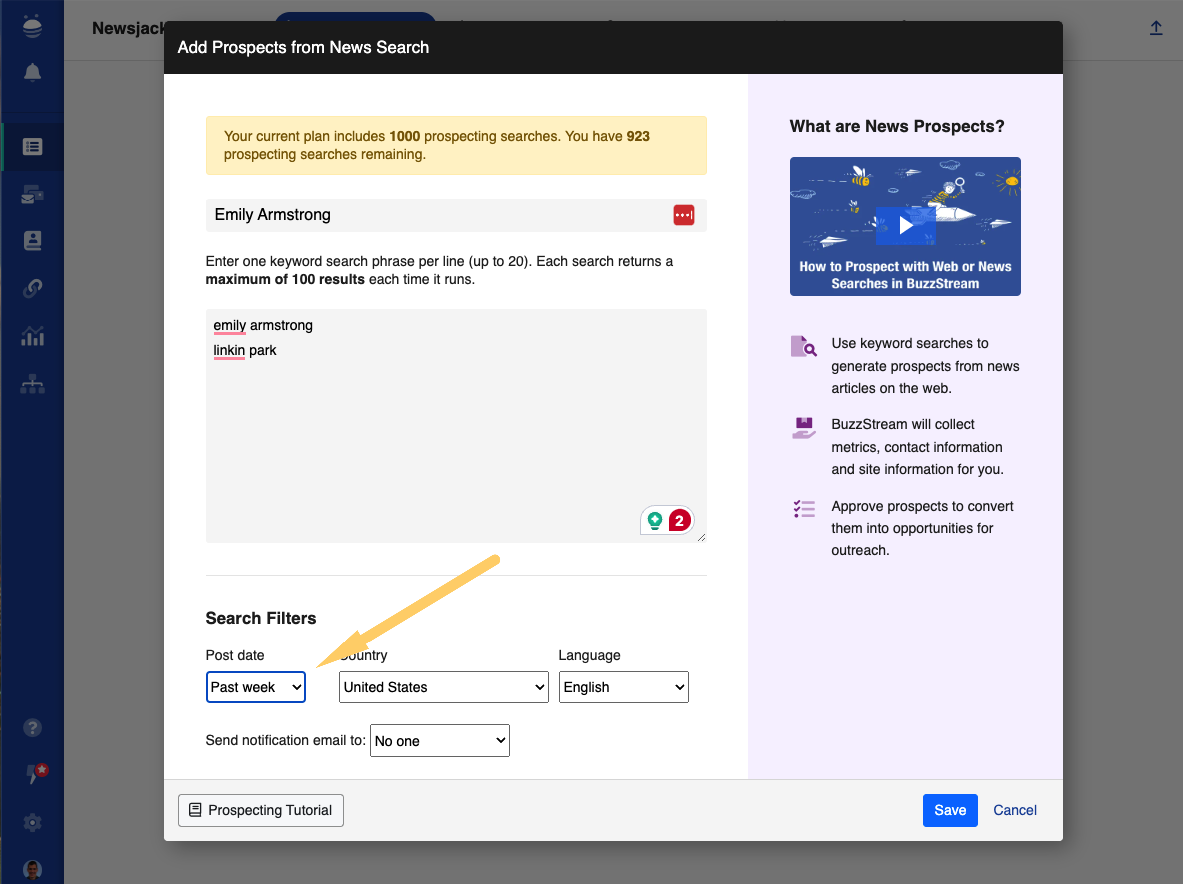
Now I have a list of news results.
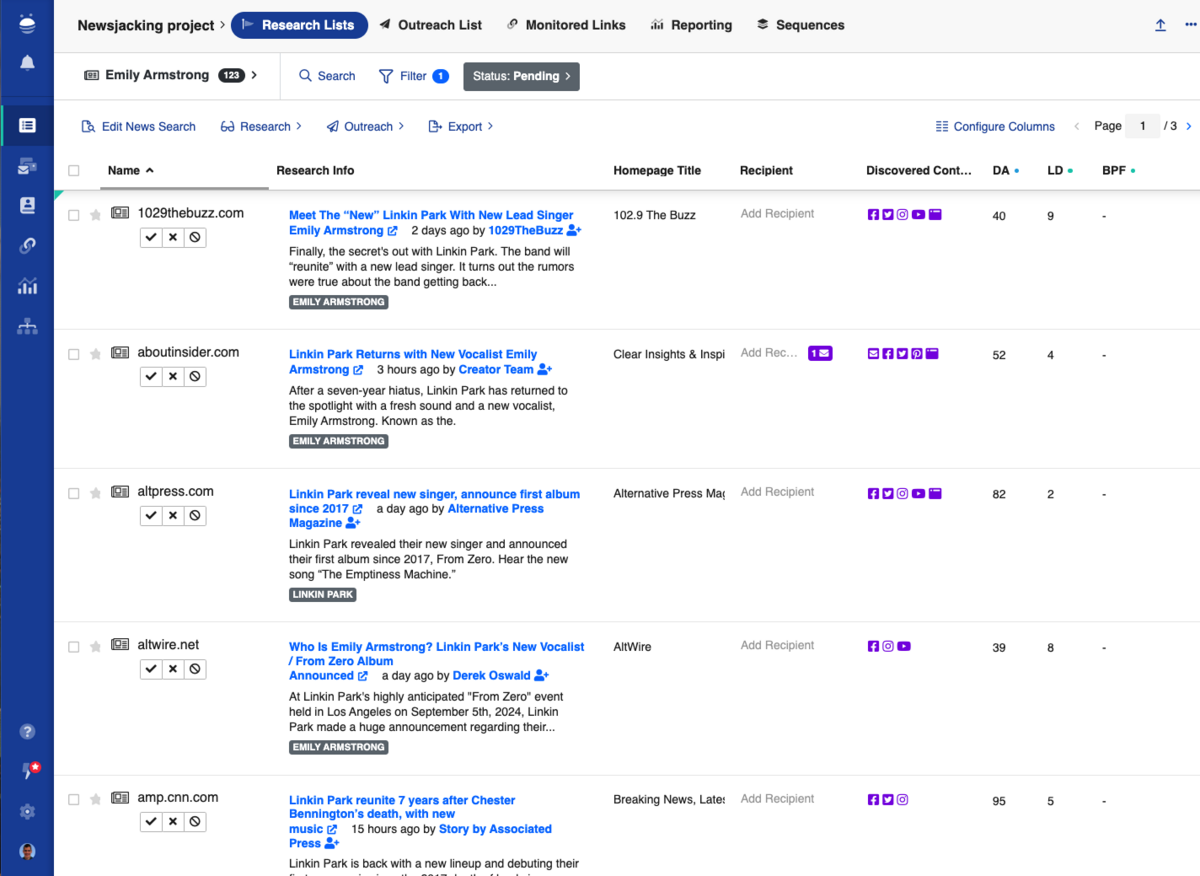
I’ll filter this list by DA to focus on the top-tier news outlets first by setting the DA to greater than or equal to 75.
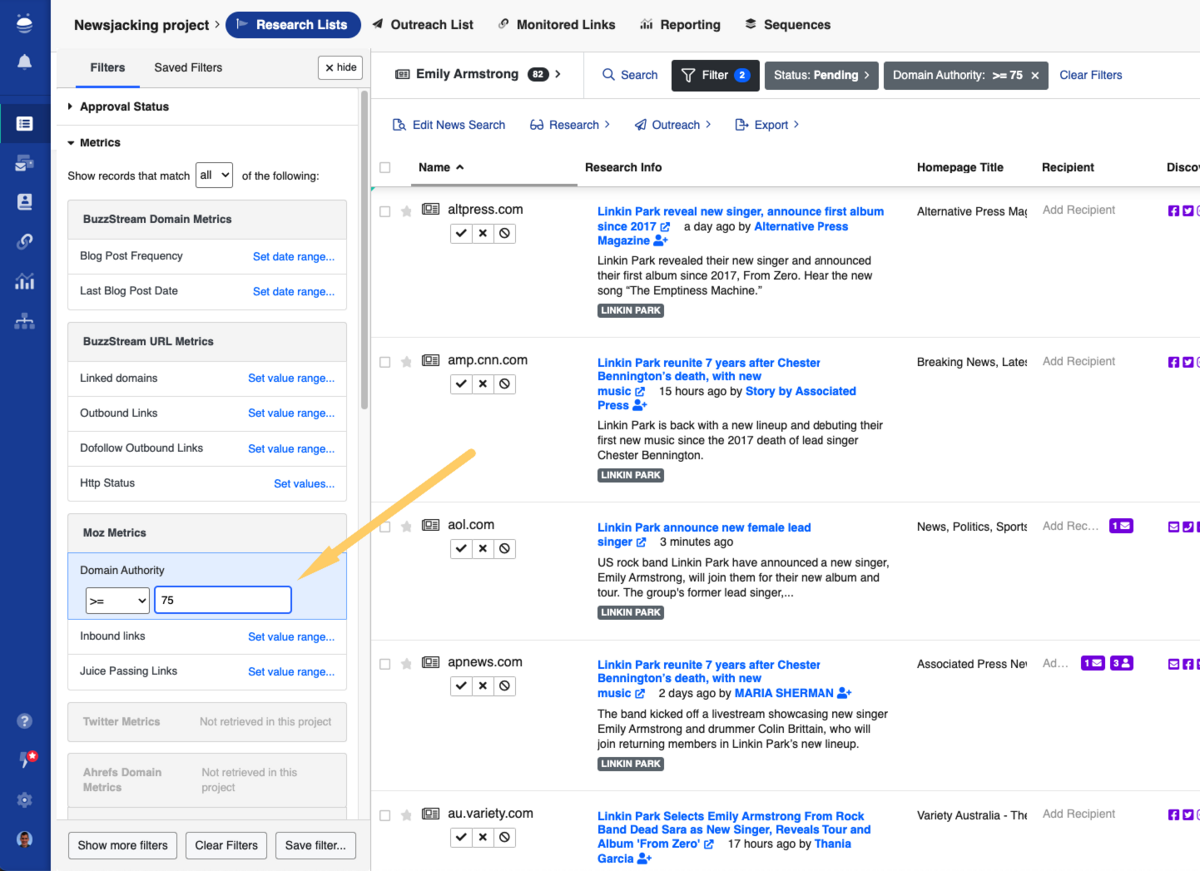
Now, all I have to do is start clicking through the articles on the list to determine if the journalist is the right fit.
I select all, click Research, and select Review on the Web.
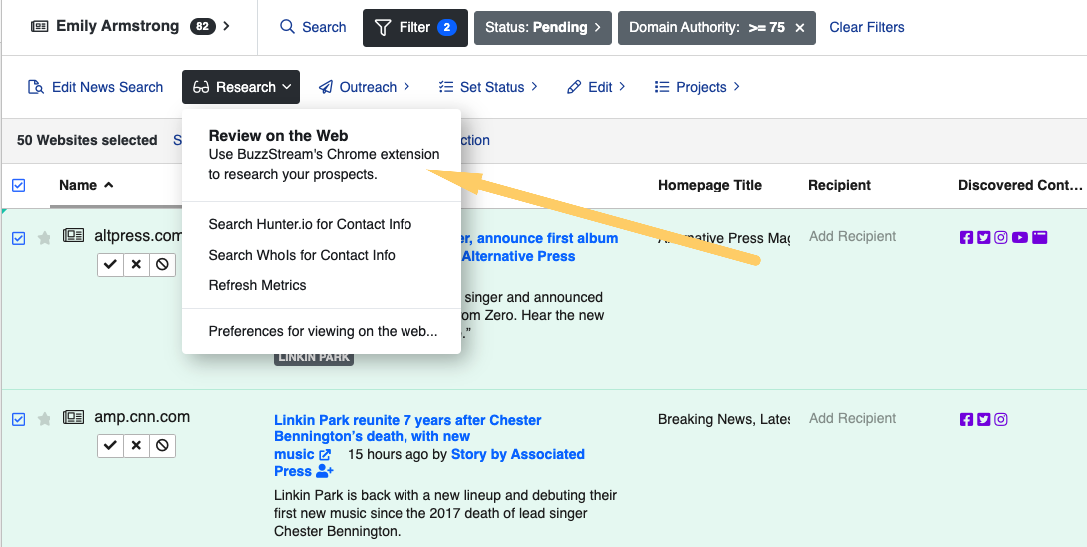
Now, I can go through it individually and accept or reject the outlet and journalist.
The site is shown on the left, and BuzzMarker displays helpful information, such as discovered contacts. You can also Approve and Reject contacts to add to your outreach list.
The first doesn’t seem to be a great fit as it’s not a news outlet and doesn’t seem to cover data studies.
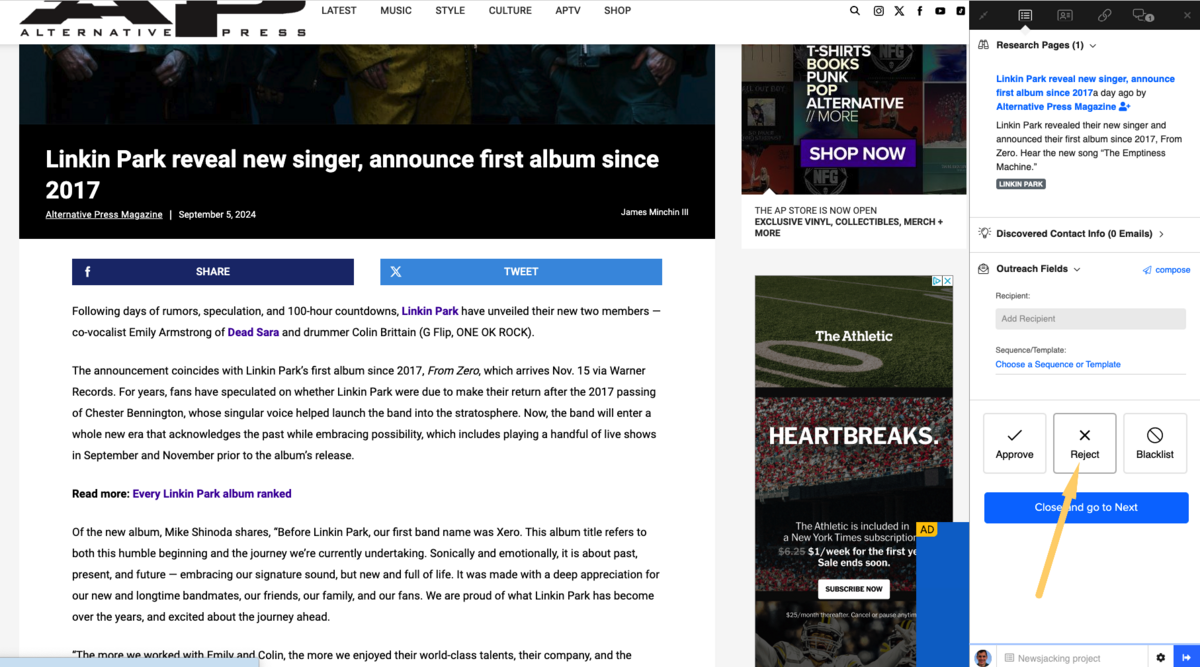
However, Thania Garcia from Variety looks like a good fit.
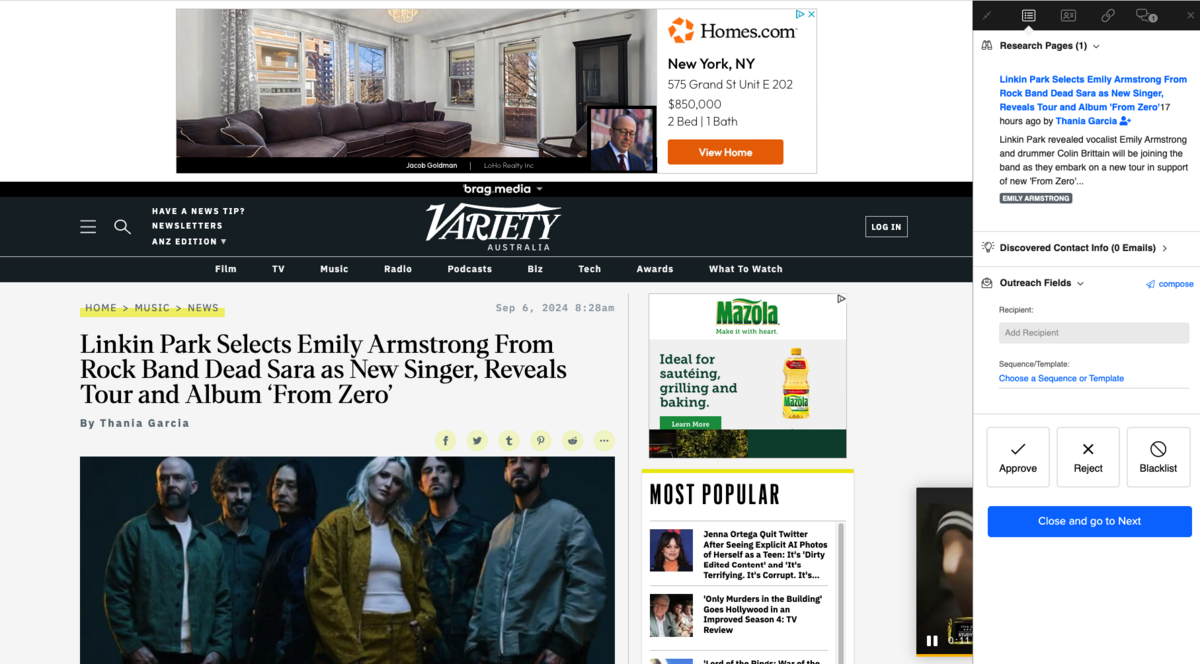
So, I’d click Approve, which adds it to my outreach list.
BuzzStream also uncovers journalist’s email addresses automatically whenever it finds them.
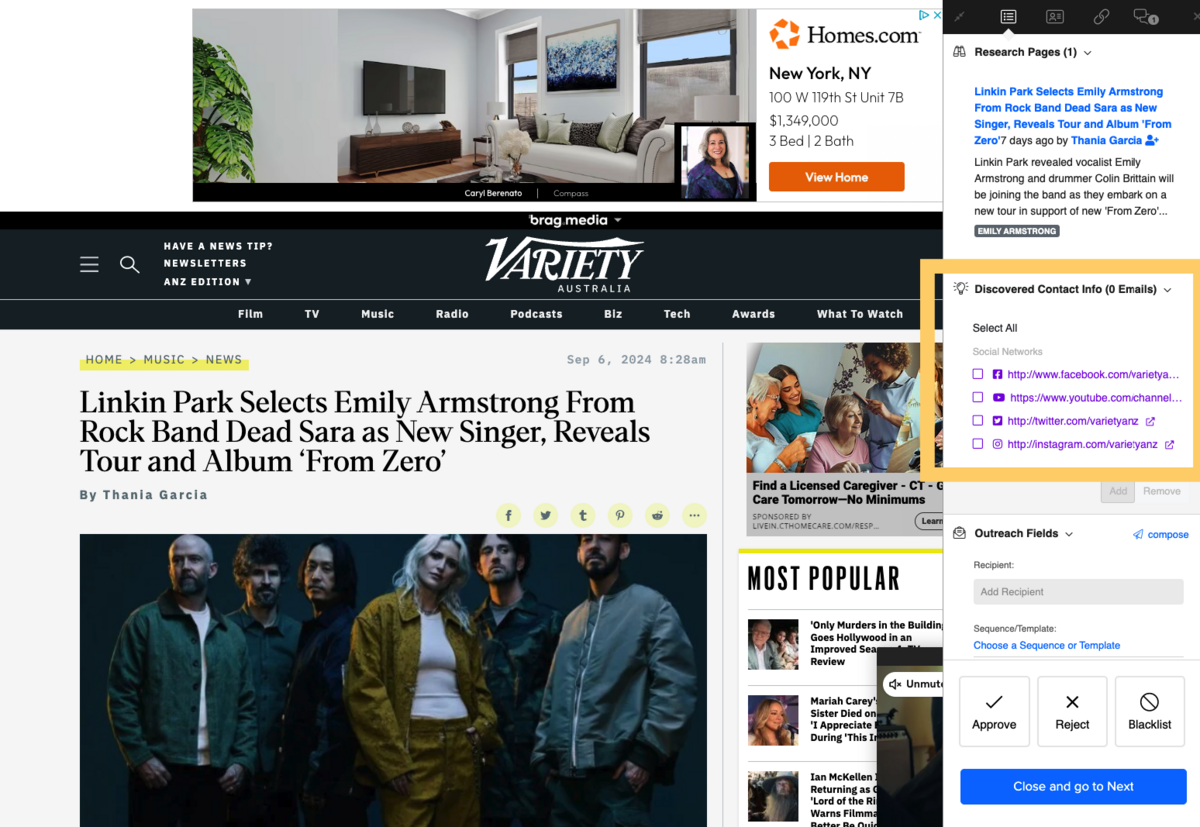
In this case, Thania Garcia’s email address is not published on the site.
No worries, we can use a Google Search.
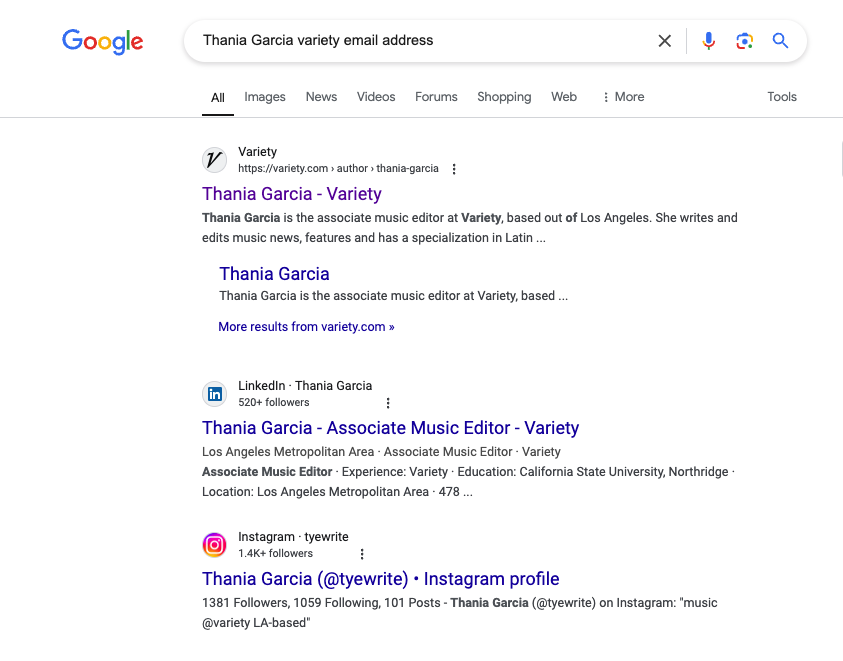
I see nothing evident on Google, but she has a LinkedIn. Using a tool like Wiza, I can easily find (just about) anyone’s email on LinkedIn.
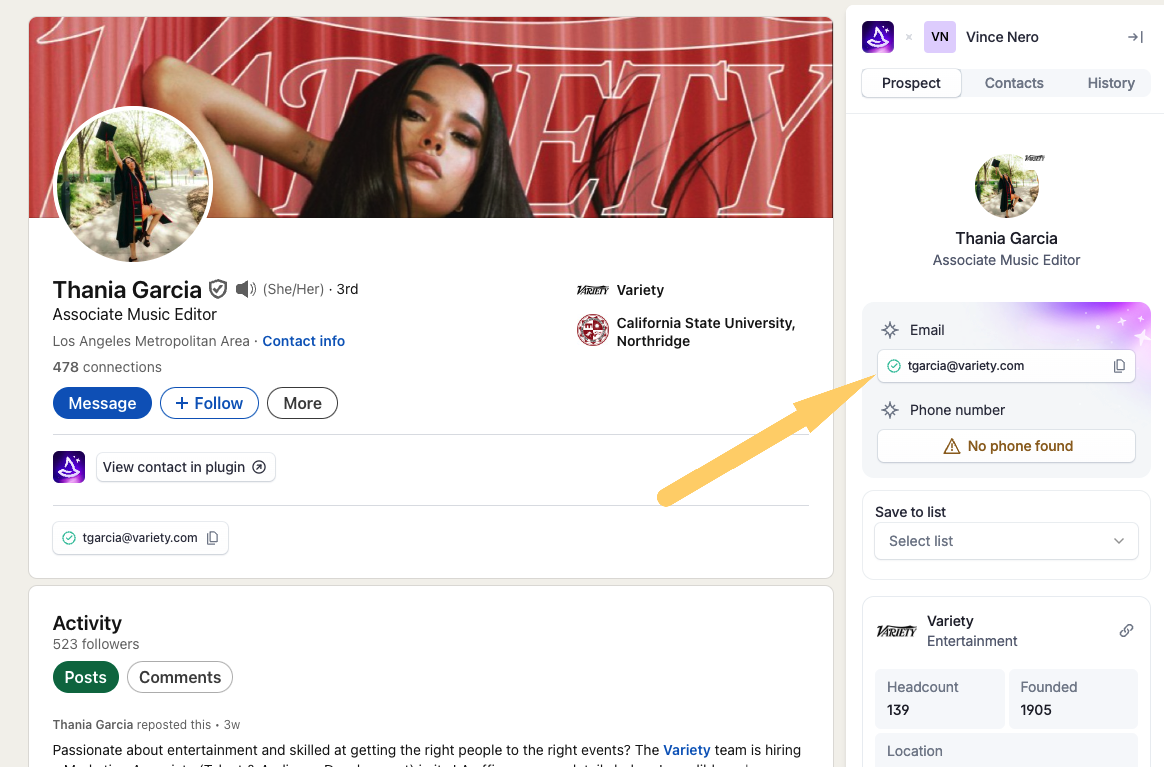
Now that I have her email, I’ll add it to the Contact Info section of the BuzzMarker.
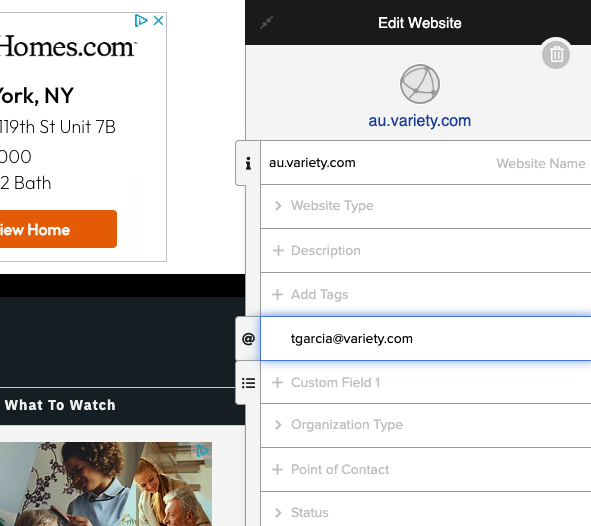
As I add websites to my outreach list, I see that they populate here in the Outreach List tab:
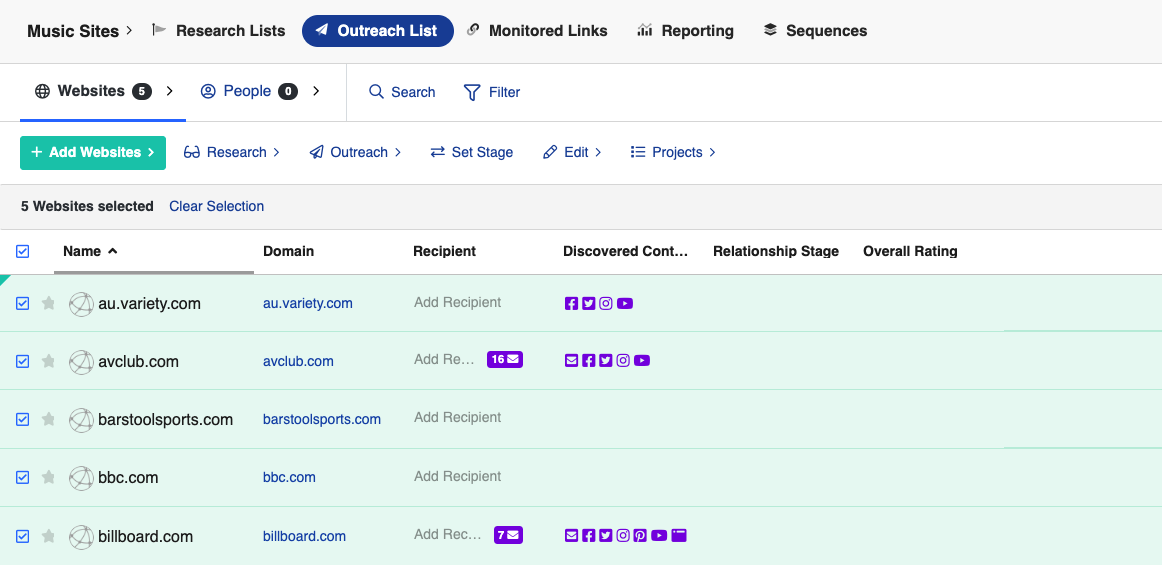
Next, I can craft and send my pitches.
Crafting Emails in BuzzStream
First, I’ll start by creating an email pitch template.
I click on the Sequences tab and then Templates.
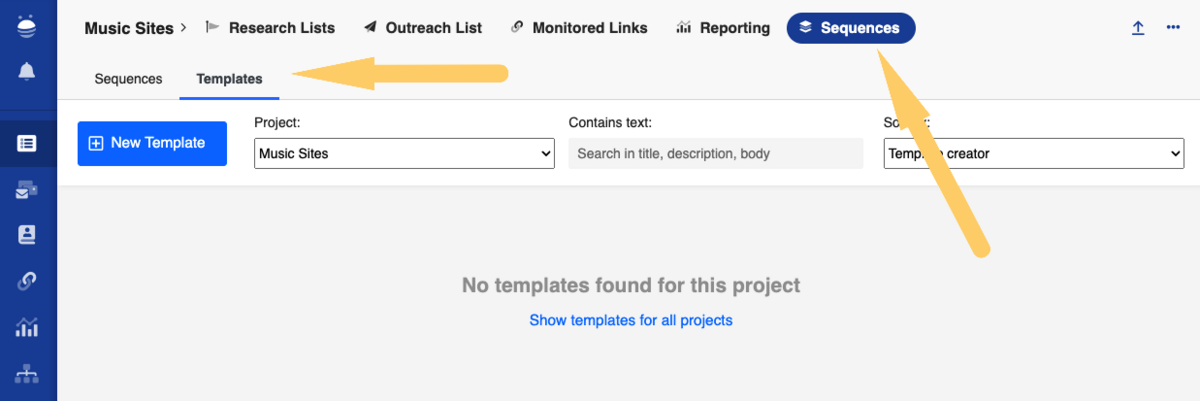
Click on New Template, and craft the email using Dynamic Fields like [First Name] to personalize.
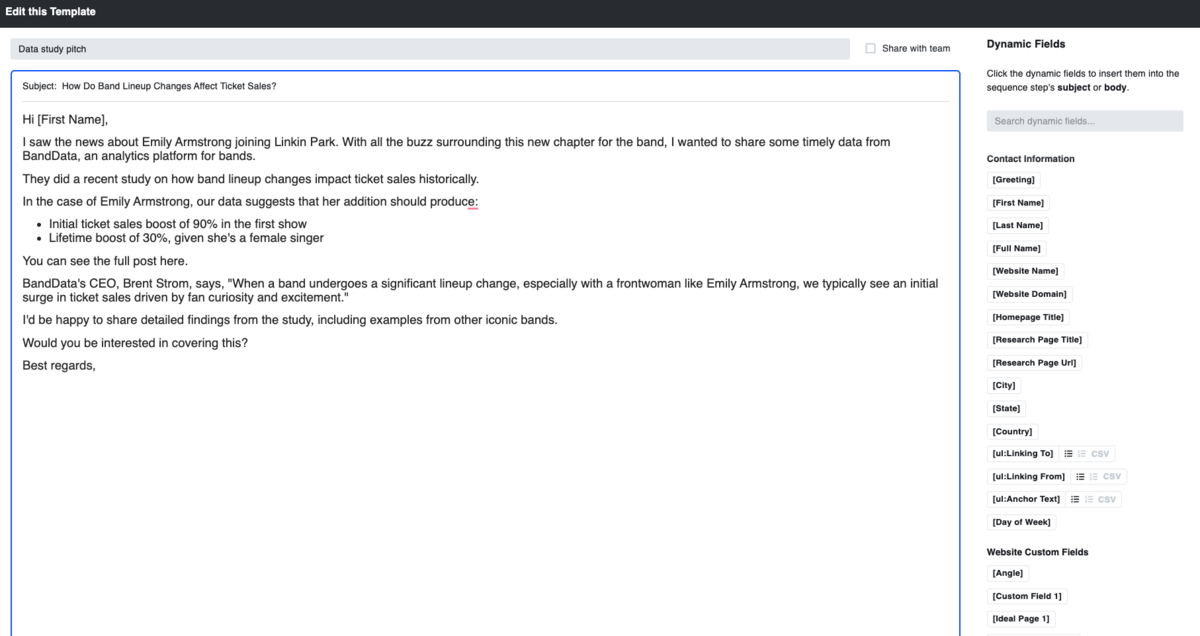
Once the template is ready, I can move to my outreach flow.
Emailing Journalists
The easiest way to send emails is to go to the Outreach List and select all the websites I’d like to email.
Then I click Send Individually.
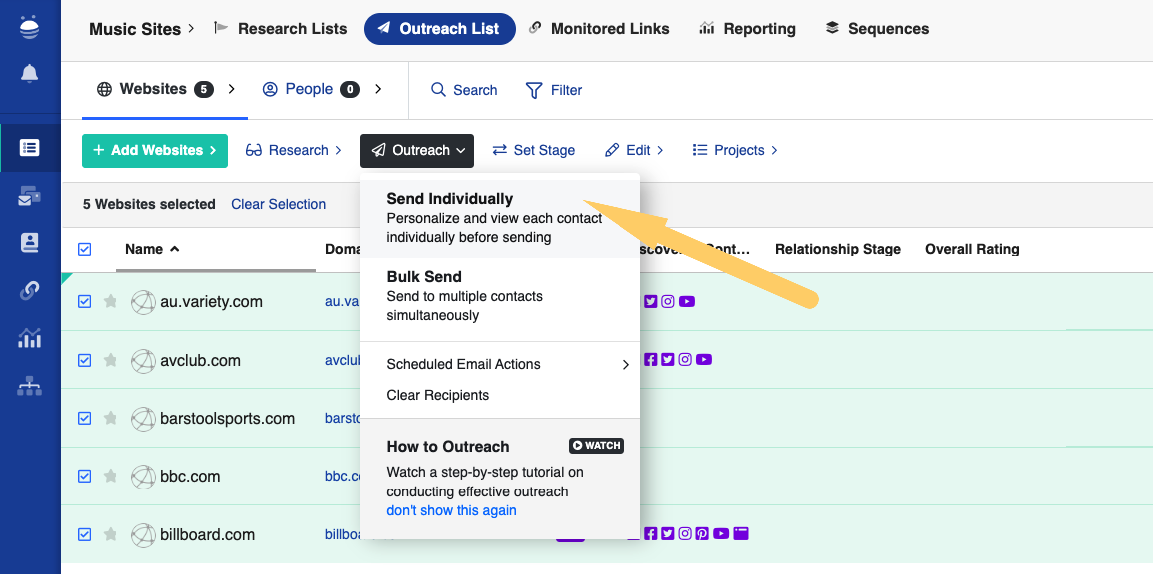
Next, I choose my pre-written template and click Start Outreach.
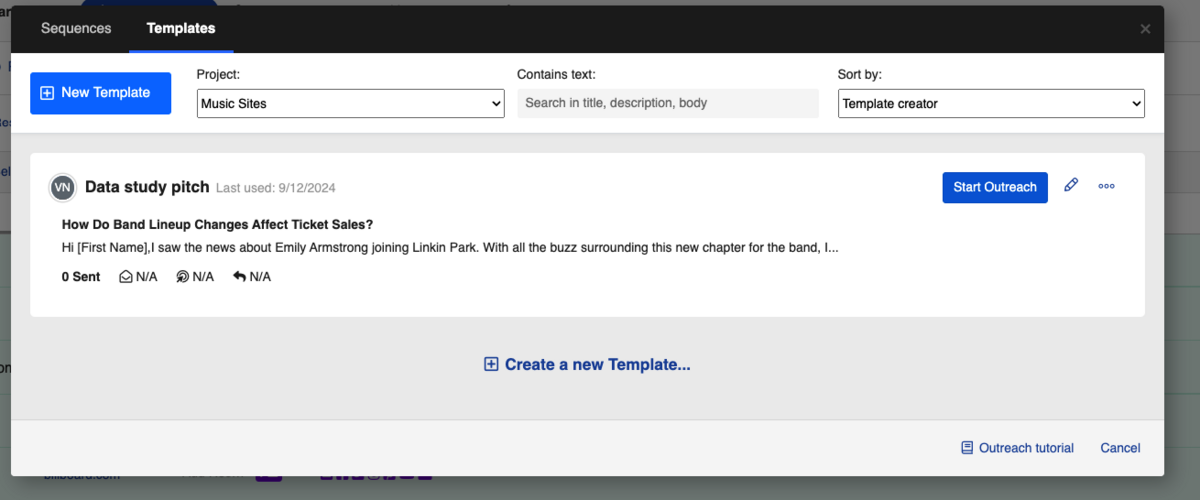
My email template is automatically filled in based on the information I provided in the research phase.
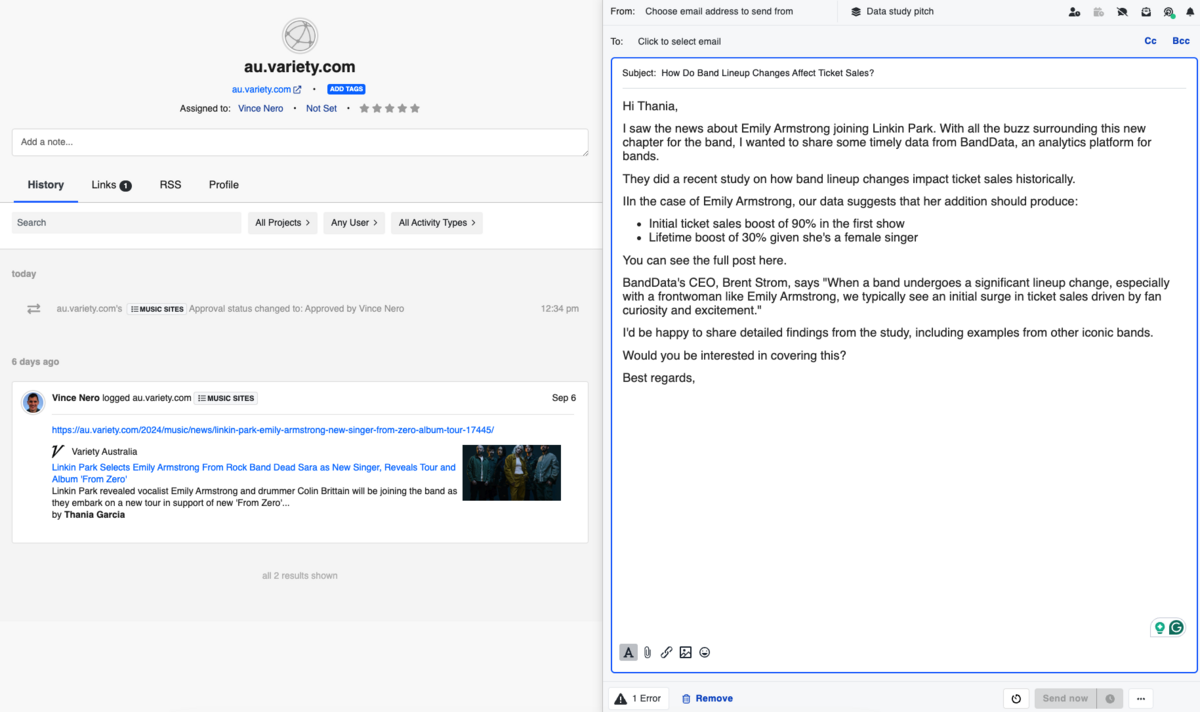
I’ll read over the email, personalize anything in the email itself specific to this journalist, and click send.
That’s it!
Why Newsjacking Fails (and How to Fix It)
Like any PR, newsjacking can fail for numerous reasons. Based on our experience, here are some of the most common ways newsjacking fails.
You’re Not Quick Enough
One of the main newsjacking can fail is that you aren’t quick enough to meet the trend.
David Meerman Scott’s graphic below outlines the correct time to newsjack, after the break and before the journalists initially write about it.
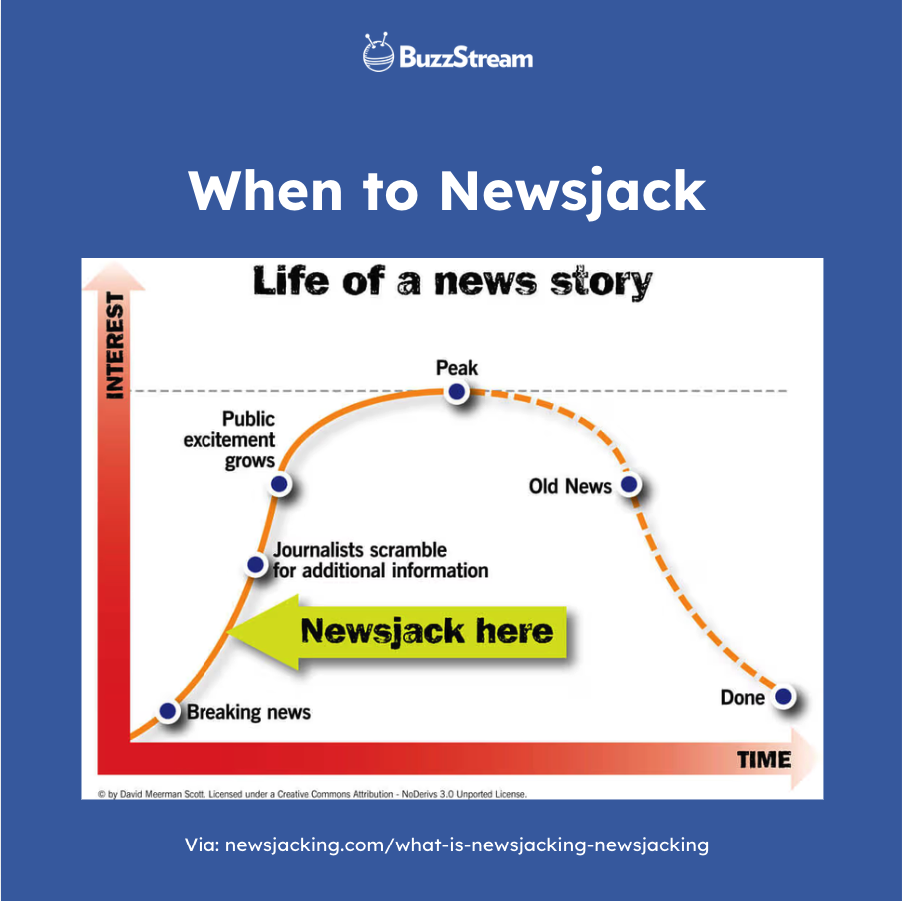
The window may be a little longer depending on the kind of information you provide, but regardless, the idea is that you want to catch the trend before it fizzles out.
Solution: The easiest way to combat this is by pre-writing quotes.
But if you are doing reactive newsjacking, how do you write a quote for something that hasn’t happened yet?
Great question!
Ask yourself what topics or events could occur in my industry and what I would want to say.
Here’s an example:
In the U.S., the Federal Reserve meets eight times yearly based on a pre-determined schedule to discuss the Fed Funds rate.
During these meetings, the rate may be raised, lowered, or kept the same, depending on economic conditions.
So, you could prepare content or expert commentary for those three outcomes beforehand.
For example, if interest rates rise, we will use quote A. If they fall, quote B, and so on.
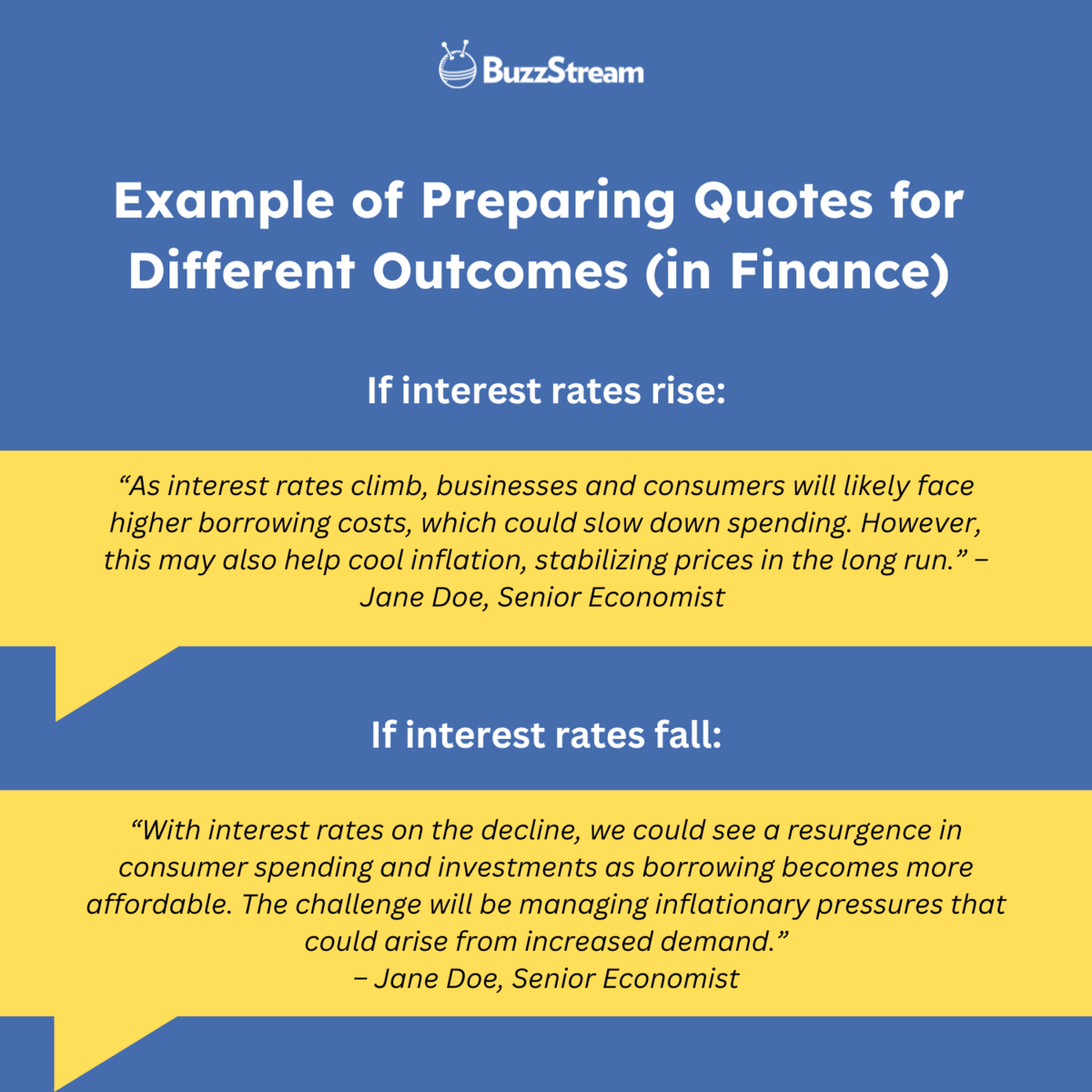
Another example is a little morbid, but one that I’ve seen occur in the construction industry.
In the unfortunate event of a bridge collapse or construction accident, having your brand prepared with statements or insights on why can mean the difference between getting coverage or missing out.
By planning ahead, you can circumvent the potentially longer turnaround times needed in larger companies that require red tape or heavy legal approval.
You won’t catch every news event by pre-writing quotes, but it can certainly help.
You Aren’t Bringing Anything New
Just like any conversation, if you aren’t saying anything new, a journalist won’t care.
For example, if your hack for cooling off during a record-high heat wave is to run the AC, that’s not bringing anything new.
“You want them to be seen as someone who is a market leader in that space…So it’s adding a comment that changes the way the journalist thinks about the topic, or is going to bring something totally new to the conversation.
What value are you adding rather than just explaining the situation?
A lot of the time it’s like giving a top tip or hack that not everyone’s already heard of.”
Instead, maybe you can newsjack a historic heatwave by pitching a tip about cooling off by eating spicy food. It’s surprising yet true and would certainly stand out.
You’ve Picked a Topic That’s Too Crowded
In our podcast chat with Mark Rofe, the digital PR expert behind the Digital PR Newsletter and Digital PR Course, he discussed the existence of a PR matrix with unplanned vs. planned and high-interest vs. low-interest events.
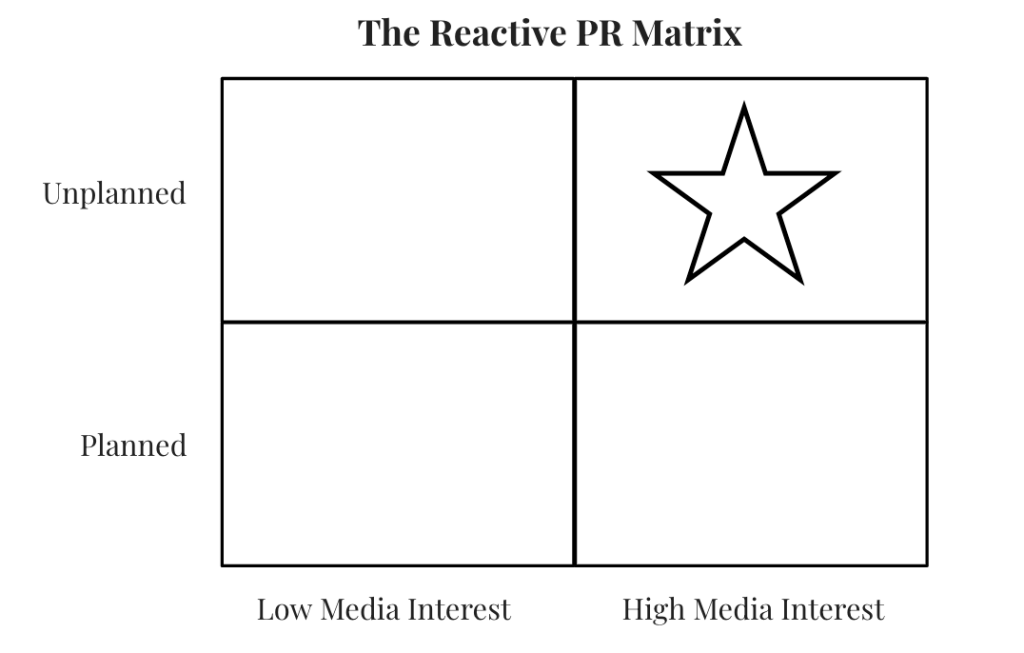
A high-interest event might be the Superbowl, whereas a low-interest event is a local (American) football match.
Solution: Think about current events using this matrix to prioritize your strategies based on the likelihood of getting coverage.
If you focus too much on High Interest, planned events, you’ll most likely hitting inboxes that are much too crowded.
Hitting too low and you might not get the reach you want.
Mark recommends trying to find those unplanned, yet high media interest topics.
You’re Not Relevant or an Expert in the Topic
James Brockbank, founder of Digitaloft, recommended a simple question to ask yourself in our podcast episode on content relevancy: “What do you have the authority, the expertise, and the experience to talk about?”
To illustrate a bad connection, he gave a great example of a casino website giving tips to a news site in Leicestershire on dealing with pollen and hay fever.
Ok, so this hacked me off last year but now I’m wondering if I’m missing something?!
Please, can someone tell me the relevancy of a gambling brand talking about hayfever??https://t.co/ElWlcyH74J
— Lou Ali (@Lou_LouD) April 24, 2024
It subsequently received some negative press because the comment provider seemingly didn’t have the authority or expertise to give medical advice.
Instead, an “expert comment” on dealing with hay fever would have made more sense coming from a doctor or at least a medical-related site.
Solution: Always ask yourself if you are authoritative enough to speak on this topic.
Another recommendation from James that I liked was to pretend that you would get interviewed on TV (which is a genuine result of newsjacking outreach).
If you aren’t ready to appear as a spokesperson who can answer even more questions about the topic, you probably aren’t an expert or relevant enough.
The Campaign is Tone Deaf
Frequently, campaigns can run the risk of tone-deaf newsjack.
I’m looking at you, SpaghettiOs.

Remember, not every brand needs to comment on everything.
Solution: In general, it’s best to avoid overly sensitive topics like death, suicide or war.
It can be hard to see the forest from the trees, so I always recommend running your ideas by a few people outside of your company first.
Newsjacking, SEO, and Beyond
As we’ve seen, newsjacking can be incredibly beneficial for your brand for many reasons.
But to get the most out of your efforts, both from an SEO and brand standpoint, you need to think strategically.
If the content or commentary you provide with newsjacking is relevant to your brand, the links that you get from newsjacking will support your SEO strategies.
Building on that, you can also push journalists to use the right keywords when writing about you.
If you tell journalists how to refer to you in your pitch, they will most likely follow suit. That’s why the boilerplate or explanation of your brand is so critical.
Sometimes, all it takes is a cleverly placed keyword within your subject line or pitch email.
The results led to a significant increase in the relevant keywords for which they were ranking.
The more you can align your brand and SEO goals with your digital PR strategies, the more successful you will be.

 End-to-end outreach workflow
End-to-end outreach workflow



 Check out the BuzzStream Podcast
Check out the BuzzStream Podcast







